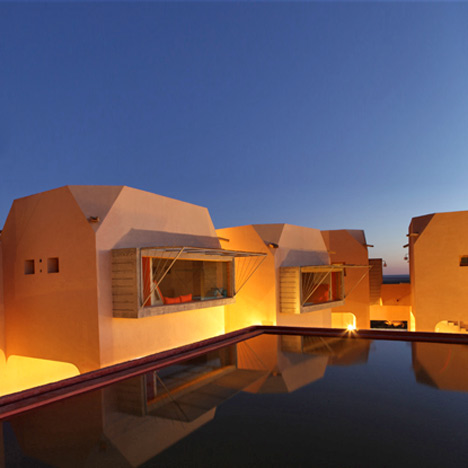
Dar Hi by Matali Crasset
French designer Matali Crasset has completed a hotel in Nefta where bedrooms are located in eight individual towers overlooking the Tunisian desert.
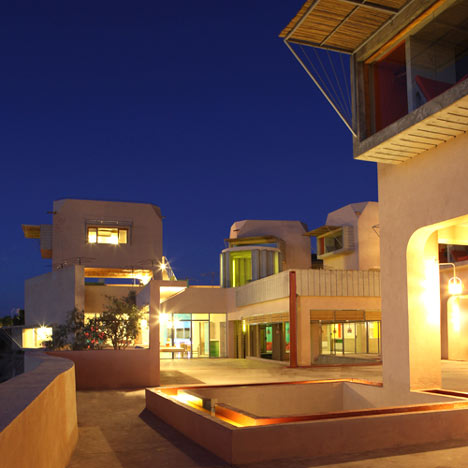
The Dar Hi resort is laid out like a village and features ochre-coloured structures on pilars, enclosed by an exterior wall.
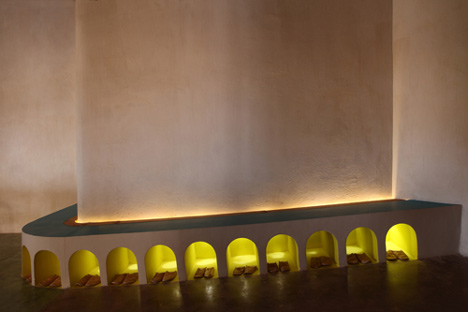
Upon entering the resort, guests take off their shoes, swapping them for Tunisian slippers.
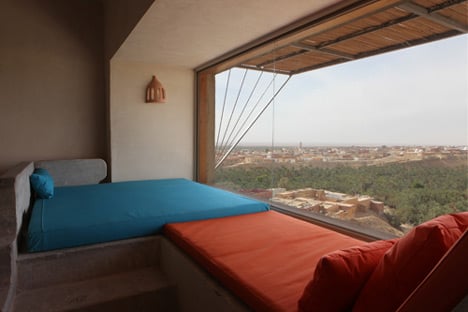
Beds are arranged next to the large windows with cane shades, affording panoramic views of the surrounding landscape.
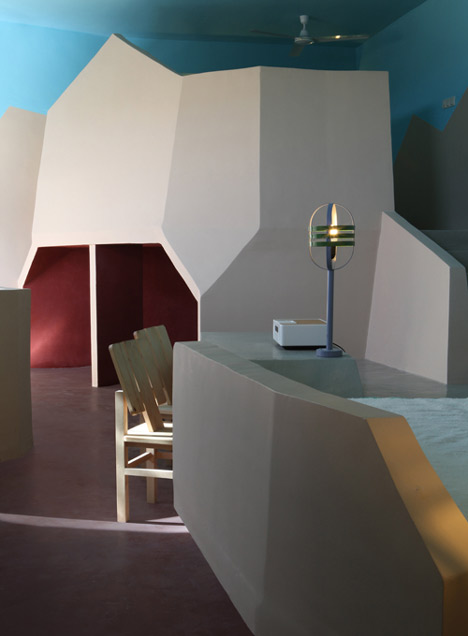
Faceted walls create little areas to relax in the communal spaces.
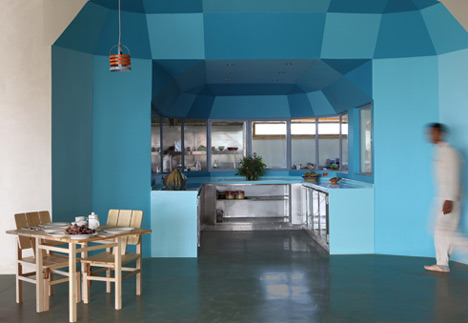
Glass panels in the cooking area separate guests from the chefs.
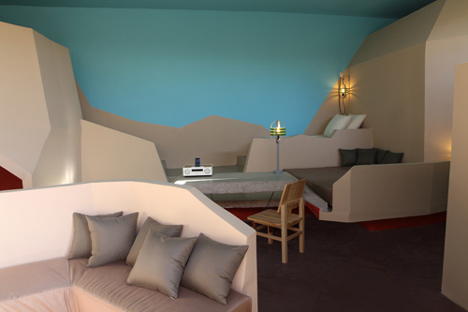
A spa, pool, library, living room, auditorium and kitchen are included within the resort.
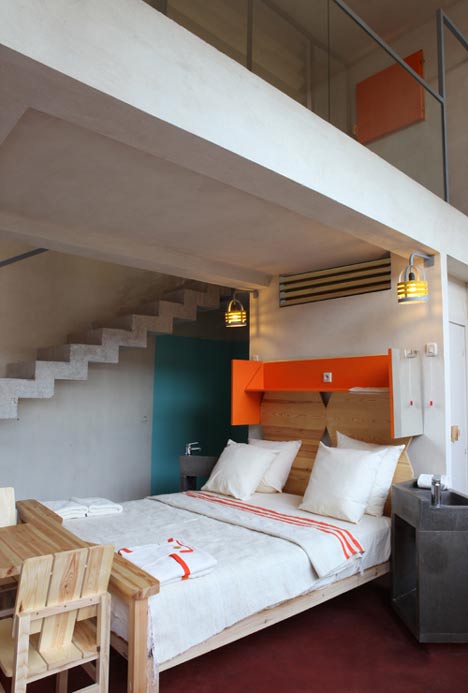
Locally sourced materials including clay bricks and palm wood are used throughout.
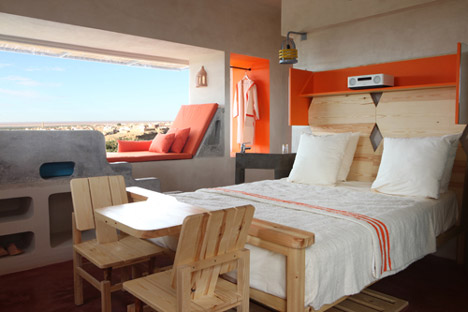
More hotels on Dezeen »
More projects by Matali Crasset »
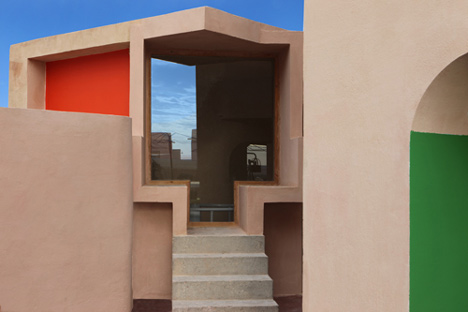
Photographs are by Jérôme Spriet, Dar Hi.
Here's some more information about the resort:
Dar Hi The first architectural project signed matali crasset
matali crasset created an ecological house in the Tunisian desert. After the experience of the HI hotel in Nice, now Dar HI in Nefta which is the fruit of the collaboration between matali crasset, Patrick Elouarghi and Philippe Chapelet with a new concept of eco-retreat. Matali literally rose a citadel, from the sand, dedicated to well being. Protected by surroundings walls you find a composition of elevated houses that constitute the Dar HI as a small village. The overall architectural goal was to give a strong proposition while in harmony with the natural site and the local life.
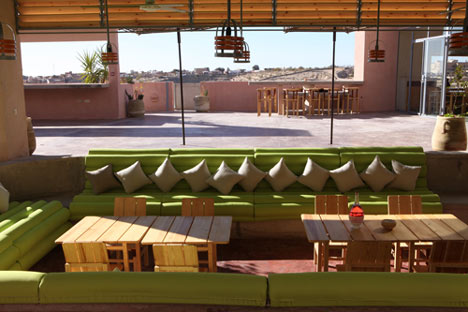
Dar HI’s main colours are ochre and sand with a comprehensive choice of body and spirit care within areas that are private or communal, a pool, a restaurant and a Spa. The dialogue and collaboration between Philippe Chapelet, Patrick Elouarghi and matali crasset started in 2005. They all decided to push the contemporary experience a bit further with Dar HI a new concept of hospitality and serenity. They all have a common interest always to question their ideas and the desire to conceive innovative projects; those are the main reasons why their collaboration is so dynamic. matali crasset develops a design that is meant to be practical and believes in initiatives that have a sense locally but also collectively. Patrick and Philippe are creative entrepreneurs that are always ahead of their time.
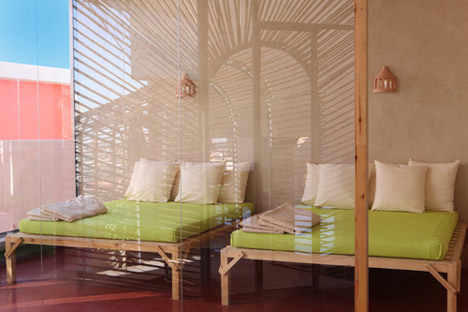
They are driven by the renewal of propositions, the reinvention of codes and sites and the research on contemporary hotel industry and well being. These strong set views unite them for an intransient length of time. After Nice and the HI hotel, Paris and the HIMATIC, it is now Tunisia with Dar HI. Dar HI is not only another project. “The HI Hotel wasn’t meant to be duplicated: it has been conceived as a laboratory that is not duplicable”, says matali.
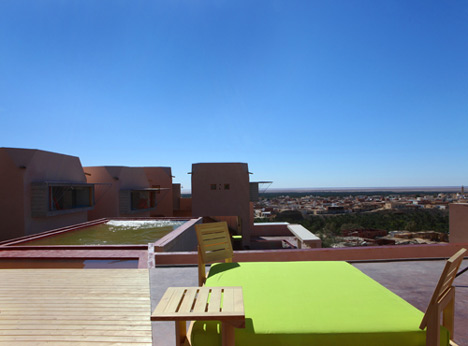
The Dar HI project is articulated around notions of well being and eco-retreat in an unexpected and magical site. “Dar HI is not a hotel nor a classical SPA but more a place where you can experience withdrawal and benefit from a spiritual thalassotherapy a few hours away from Paris and in the middle of the desert”, explains Patrick Elouarghi.
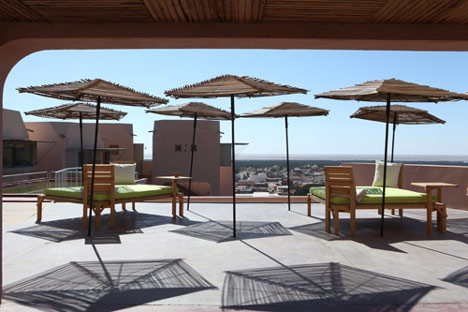
The DARHI team has created privileged relationships with the inhabitants of the village who will be taking care of the house. The gardeners will till the garden that will be the main source of vegetables and fruits. The cooks will propose a variety of local and simple dishes. No high gastronomy nor imported products, even less so called authentic cuisine for tourists, but a self sufficient and local development approach. Here artificial folklore is not necessary.
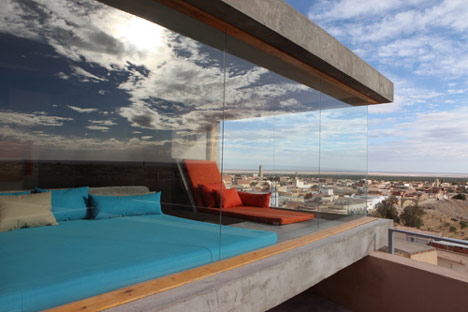
To access the Dar HI you walk towards it and this is the beginning of your stay. The car has been left further from the house. A discreet door leads you to imagine that you walk in a private house. The entrance, a corridor, a ramp is the last stop where you leave your “codes” at the exterior. You take off your shoes and wear babouches (Tunisian slippers). You are at home. As you can find in the traditional foundouks, Dar HI is a house in which the stays are pro- longed, at the opposite of short stay tourism. The organisation of the areas favours the different possibilities to either share moment with other people or to be in a calm retired place to rest. The guests can do as they please according to their wish.
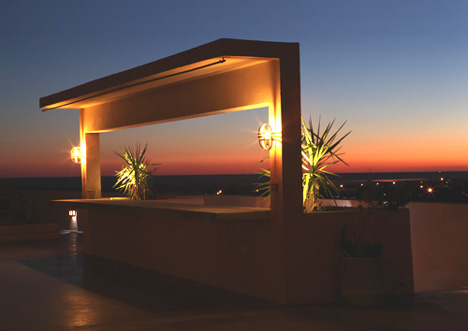
In the same spirit as a bed and breakfast, Dar HI’s team offers a simple yet friendly service. The objective is to feel at ease without being annoyed constantly and fully enjoy the house. At Dar HI there is no shame for being lazy, observe, read, loiter, take care of your body and your mind, to discover at your own rhythm local life, and slowly let yourself go to the site’s atmosphere. Guests feel free to organise their lives indoor or outdoor and free to discover Nefta and its wonderful surroundings. If you are a curious traveller, for a unique experience, it is also possible to spend a few days during your stay within the date grove in a palm tree tilt or try out a typical house the Dar Malika that is close to the Dar HI.
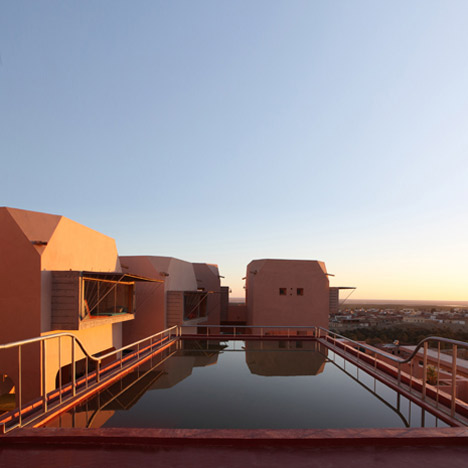
3 site typologies
“I have conceived an architecture that is towards the indoor when outside and towards the outdoor when you’re inside, exploding the codes” explains matali. With the surrounding wall, typical of local architecture, Dar HI follows the movement of the terrain, following the shapes of the site and emerges from the sand as a mirage citadel. Inside, the elevated houses seem to be planted into the sand and they structure the project. They are located according to their sun exposure and panorama. “This architecture of pill houses allowed to propose different scenarios that can be lived at Dar HI” says matali. The pill houses are elevated above the surrounding wall and offer different panoramas: the date grove, the village of Nefta or the Chott-El-Jerid. matali crasset designed 3 different areas: the pill houses, the troglodytes and the dunes. Each possibility has interaction with the site and hotel life (interior terrace, pool, ham- mam ...) and its guests.
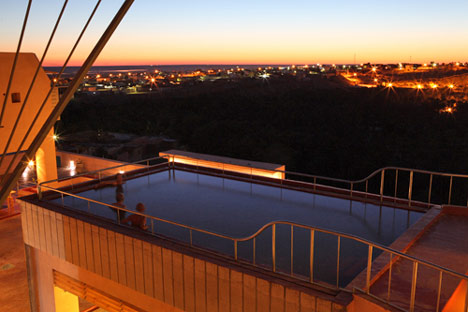
The pill houses
These houses have exceptional views that are all different. Some have a panorama over- looking the horizon of the salted lake, others have a view of the palm grove and its very diverse landscape. Both are very different, one is more intimate being high above the ground with a panoramic view and the other on the lower ground so more amongst the communal area.
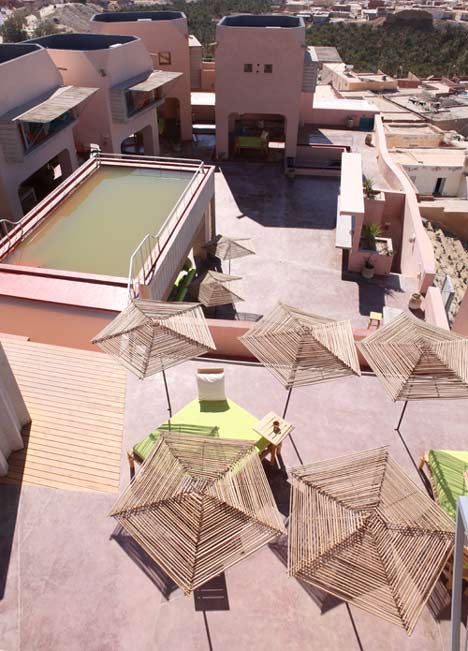
High above the ground the room is structured around a bow window, as if the view was integrated in the room. A small table to nibble or work, a large bed that hides part of the shower and toilets compose the room. Down below it is like a small village square. Everyone has a space that is protected from the sun. The square, the bar, the water point and small fountains are all places to be easily together.
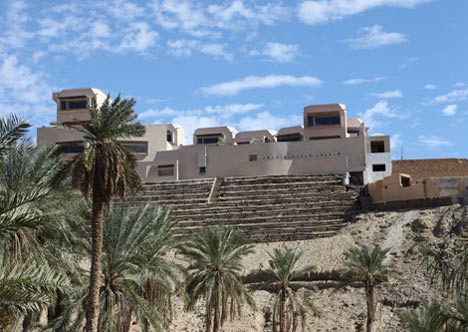
The troglodytes: for a mineral experience Three areas called troglodytes with small bricks from Nefta are completely independent with their own private terraces but also linked together by a circular area from one to the other. Collective life is articulated around a small square with a small water cascade and a bread oven. These rooms can be rented entirely for a stay with friends or family. The freshness reminds of the typical troglodytes houses of Matmata.
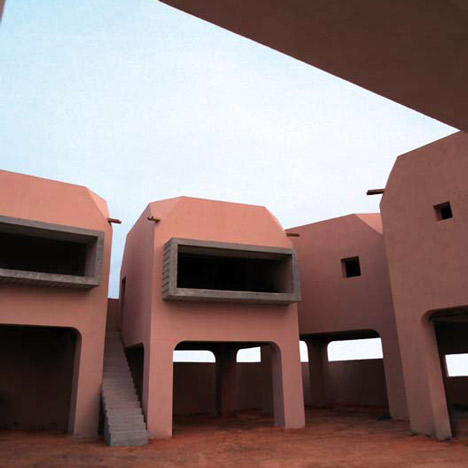
Above: during construction
The dunes: to have the feeling of having an indoor landscape The three areas called dunes are at sand level. They are like open spaces that the wind would have sculpted. The inspiration was the bivouac that allows you to modulate your comfort as you wish. The experience of living within the dunes creating your own nest to feel closer to the desert. They are all different, one has a loggia with a natural light and an indoor garden, the other very spacious has an external terrace and a large window with a view of Nefta, the third one also very spacious and fresh. It offers a view on the date grove with an independent room and an alcove wooden terrace.
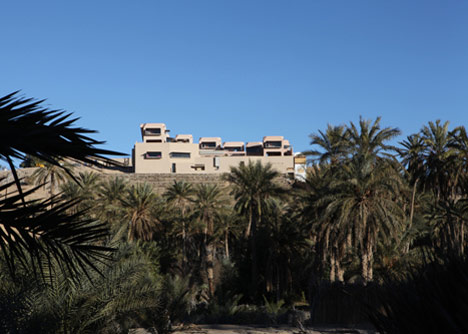
The communal spaces
Dar HI has different communal areas that are places to meet and share. “Leaving the communal areas as open as possible, I wished to leave an easy circulation with a large potential to use the area as much as possible” says matali.
The kitchen: open on the exterior It is a laboratory where you can see the cooks at work, all from Nefta village. The area is also open for the guests every hour of the day or night. There is no area dedicated for the restaurant but a large table and small tables that can be arranged.
The auditorium: an area that changes according to the activities Cinema, music, rest ... It has foam material seating that have the superior part that can be used as a back rest. As there are no televisions in the rooms this area allows people to gather and listen to music or watch a movie. The library: around the staircase Like a hedgehog, the staircase has wooden sticks where books are placed and easily accessible. You can come choose a book, read it, put it back or sit comfortably to read it.
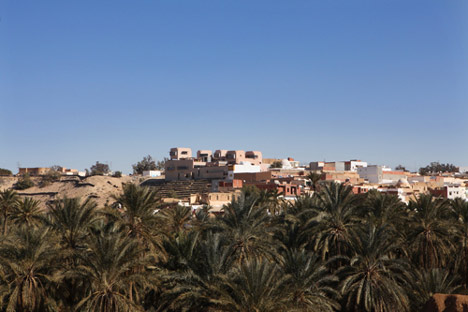
The modular living area
With poufs, it is a very agreeable area that you can build yourself. With alcoves, suspensions in terracotta and its chimney, it is a nice area for intimate and warm evenings.
See also:
.
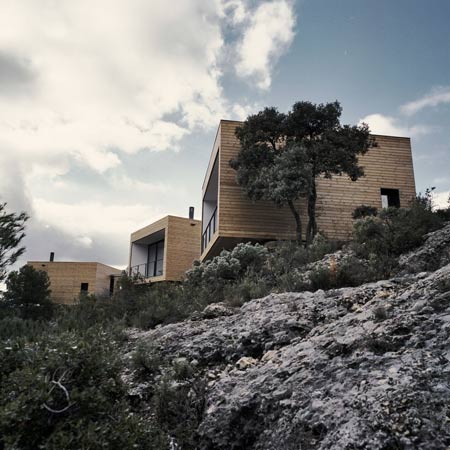 |
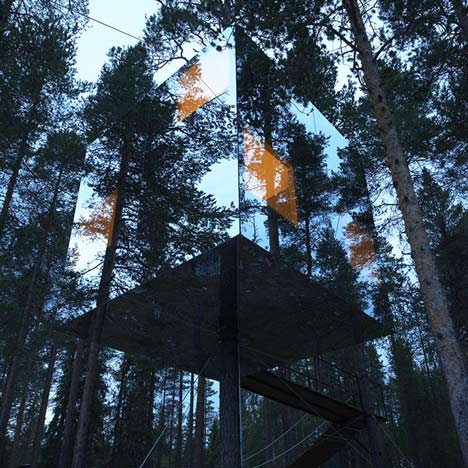 |
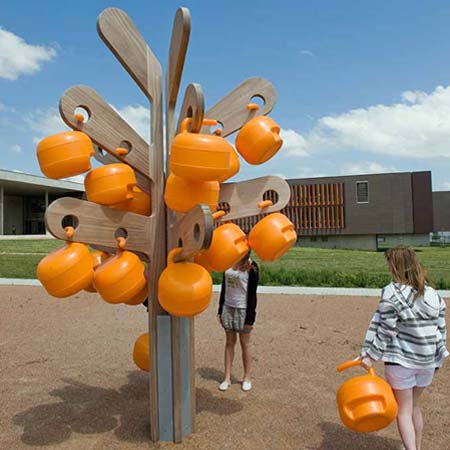 |
| Hotel by Camprubí i Santacana Arquitectes |
Tree Hotel by Tham & Videgård Arkitekter |
More projects by Matali Crasset |